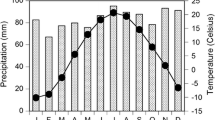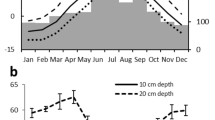Abstract
Cork rings have been extensively used in dendroecological studies of the Mediterranean evergreen cork oak (Quercus suber L.). Through measurements of cork-ring width only, strong relationships have been found between cork-ring widths and climate parameters. To our knowledge, cork-ring density, which is an important cork quality attribute, has never been used in any dendroecological study to explore physiological responses of the cork oak to climate change. In this study, we measured cork-ring width and density over 50 years (1962–2013), corresponding to five consecutive cork harvests, and analyzed their inter-annual fluctuations in eight trees from two different sites, a wetter peneplain area (Benavente) and a drier mountainous area (Grândola). Our results revealed a statistically significant correlation between cork-ring width and density (p < 0.05) at both sites; however, it was negative (r =− 0.261) and relatively weaker at Benavente, and positive at Grândola (r = 0.410). Moreover, a direct relationship between cork density and spring–summer temperature was found only at Grândola. Here, cork growth sensitivity to inter-annual variability of precipitation and temperature in summer-autumn of the current growth year (p < 0.01) was the highest and, respectively, positive and negative. We conclude that in drier Mediterranean environments, summer drought stress might negatively affect both cork growth and density, by changing tree physiological processes involved in cork formation, resulting in narrower and denser cork rings. Considering scenarios of future climate change effects in Southern Europe, in particular the longer drought periods and rising temperatures, it seems that both cork yield and cork density will be affected, with implications on cork quality.




Similar content being viewed by others
References
Aguado PL, Curt MD, Pereira H, Fernández J (2012) Allocation of 14C assimilated in late spring to tissue and biochemical stem components of cork oak (Quercus suber L.) over the seasons. Tree Physiol 32(3):313–325. https://doi.org/10.1093/treephys/tps012
Balzano A, Battipaglia G, Cherubini P, De Micco V (2020) Xylem plasticity in pinus pinaster and quercus ilex growing at sites with different water availability in the mediterranean region: relations between intra-annual density fluctuations and environmental conditions. Forests 11(4):379. https://doi.org/10.3390/f11040379
Barbaroux C, Bréda N (2002) Contrasting distribution and seasonal dynamics of carbohydrate reserves in stem wood of adult ring-porous sessile oak and diffuse-porous beech trees. Tree Physiol 22(17):1201–1210. https://doi.org/10.1093/treephys/22.17.1201
Boden S, Schinker M, Duncker P, Spiecker H (2012) Resolution abilities and measuring depth of High-Frequency densitometry on wood samples. Measurement 45:1913–1921. https://doi.org/10.1016/j.measurement.2012.03.013
Boher P, Soler M, Sánchez A, Hoede C, Noirot C, Paiva JAC, Serra O, Figueras M (2018) A comparative transcriptomic approach to understanding the formation of cork. Plant Mol Biol 96:103–118. https://doi.org/10.1007/s11103-017-0682-9
Campelo F, Gutiérrez E, Ribas M, Nabais C, Freitas H (2007) Relationships between climate and double rings in Quercus ilex from northeast Spain. Canadian J for Res 37(10):1915–1923. https://doi.org/10.1139/x07-050
Campelo F, Ribas M, Gutiérrez E (2021) Plastic bimodal growth in a Mediterranean mixed-forest of Quercus ilex and Pinus halepensis. Dendrochronologia 67:125836. https://doi.org/10.1016/j.dendro.2021.125836
Caritat A, Gutiérrez E, Molinas M (2000) Influence of weather on cork-ring width. Tree Physiol 20:893–900. https://doi.org/10.1093/treephys/20.13.893
Cherubini P, Gartner BL, Tognetti R, Br Äker OU, Schoch W, Innes JL (2003) Identification, measurement and interpretation of tree rings in woody species from Mediterranean climates. Biol Rev 78:119–148. https://doi.org/10.1017/S1464793102006000
Costa A, Barbosa I, Pestana M, Célia M (2020) Modelling bark thickness variation in stems of cork oak in south-western Portugal. Eur J for Res 139:611–625. https://doi.org/10.1007/s10342-020-01273-9
Costa A, Barbosa I, Roussado C, Graça J, Spiecker H (2016) Climate response of cork growth in Mediterranean oak (Quercus suber L.) woodlands of southwestern Portugal. Dendrochronologia 38:72–81. https://doi.org/10.1016/j.dendro.2016.03.007
Costa A, Madeira M, Oliveira AC (2008) The relationship between cork oak growth patterns and soil, slope and drainage in a cork oak woodland in Southern Portugal. For Ecol Manage 255:1525–1535. https://doi.org/10.1016/j.foreco.2007.11.008
Costa A, Nunes LC, Spiecker H, Graça J (2015) Insights into the cork oak (Quercus suber L.) responsiveness to bark harvesting. Econ Bot 69(2):171–184. https://doi.org/10.1007/s12231-015-9305-z
Costa A, Pereira H, Oliveira A (2002) Influence of climate on the seasonality of radial growth of cork oak during a cork production cycle. Ann Forest Sci 59:429–437. https://doi.org/10.1051/forest:2002017
Costa A, Pereira H, Oliveira A (2003) Variability of radial growth in cork oak adult trees under cork production. For Ecol Manage 175:239–246. https://doi.org/10.1016/S0378-1127(02)00145-7
David TS, Henriques MO, Kurz-Besson C, Nunes J, Valente F, Vaz M, Pereira JS, Siegwolf R, Chaves MM, Gazarini LC, David JS (2007) Water-use strategies in two co-occurring Mediterranean evergreen oaks: surviving the summer drought. Tree Physiol 27(6):793–803. https://doi.org/10.1093/treephys/27.6.793
Ferreira A, Lopes F, Pereira H (2000) Caractérisation de la croissance et de la qualité du liège dans une région de production. Ann for Sci 57:187–193. https://doi.org/10.1051/forest:2000169
Fisher RF, Binkley D (2000) Ecology and management of forest soils. John Wiley & Sons, Ltd., New York. https://doi.org/10.1002/9781118422342
Ghalem A, Barbosa I, Bouhroua RT, Costa A (2017) Climate signal in cork-rings chronologies: Case-studies on southwestern Portugal and north-western Algeria. Tree-Ring Res 74(1):1–14. https://doi.org/10.3959/1536-1098-74.1.15
Giorgi F, Lionello P (2008) Climate change projections for the Mediterranean region. Glob Planet Change 63(2–3):90–104
Inácio V, Martins MT, Graça J, Morais-Cecílio L (2018) Cork oak young and traumatic periderms show PCD typical chromatin patterns but different chromatin-modifying genes expression. Front Plant Sci 9:1194. https://doi.org/10.3389/fpls.2018.01194
Leal S, Nunes E, Pereira H (2008) Cork oak (Quercus suber L.) wood growth and vessel characteristics variations in relation to climate and cork harvesting. Eur J for Res 127:33–41. https://doi.org/10.1007/s10342-007-0180-8
Leite C, Oliveira V, Miranda I, Pereira H (2020) Cork oak and climate change: disentangling drought effects on cork chemical composition. Sci Rep 10:7800. https://doi.org/10.1038/s41598-020-64650-9
Mendes MP, Cherubini P, Plieninger T, Ribeiro L, Costa A (2019) Climate effects on stem radial growth of Quercus suber L.: does tree size matter? Forestry 92(1):73–84. https://doi.org/10.1093/forestry/cpy034
Mendes MP, Ribeiro L (2010) Nitrate probability mapping in the northern aquifer alluvial system of the river Tagus (Portugal) using Disjunctive Kriging. Sci Total Environ 408(5):1021–1034. https://doi.org/10.1016/j.scitotenv.2009.10.069
Mendes MP, Ribeiro L, David TS, Costa A (2016) How dependent are cork oak (Quercus suber L.) woodlands on groundwater? A case study in southwestern Portugal. For Ecol Manage 378:122–130. https://doi.org/10.1016/j.foreco.2016.07.024
Montwé D, Spiecker H, Hamann A (2014) An experimentally controlled extreme drought in a Norway spruce forest reveals fast hydraulic response and subsequent recovery of growth rates. Trees 28(3):891–900. https://doi.org/10.1007/s00468-014-1002-5
Natividade JV (1934) Cortiças—Contribuição para o estudo do melhoramento da qualidade. Direcção Geral dos Serviços Florestais e Aquícolas, Lisboa, Portugal
Natividade JV (1950) Subericultura. Ministério da Agricultura, Pescas e Alimentação, Direcção-Geral das Florestas, Lisbon, Portugal
Oliveira G, Costa A (2012) How resilient is Quercus suber L. to cork harvesting? A review and identification of knowledge gaps. For Ecol Manage 270:257–272. https://doi.org/10.1016/j.foreco.2012.01.025
Oliveira G, Correia O, Martins-Loução MA, Catarino FM (1994) Phenological and growth patterns of the Mediterranean oak Quercus suber L. Trees-Struct Funct 9:41–46. https://doi.org/10.1007/BF00197868
Oliveira V, Lauw A, Pereira H (2016) Sensitivity of cork growth to drought events: insights from a 24-year chronology. Clim Change 137:261–274. https://doi.org/10.1007/s10584-016-1680-7
Pereira H, Graça J, Baptista C (1992) The effect of growth rate on the structure and compressive properties of cork. IAWA J 13(4):389–396
Pereira H (2007) Cork: Biology. Elsevier Publications, Amsterdam, Production and Uses. https://doi.org/10.1016/B978-044452967-1/50013-3
Quintana-Seguí P, Turco M, Herrera S, Miguez-Macho G (2017) Validation of a new SAFRAN-based gridded precipitation product for Spain and comparisons to Spain02 and ERA-Interim. Hydrol Earth Syst Sci 21(4):2187–2201. https://doi.org/10.5194/hess-21-2187-2017
Rosa ME, Pereira H, Fortes MA (1990) Effects of water treatment on the structure and properties of cork. Wood Fiber Sci 22(2):149–164
Schinker MG, Hansen N, Spiecker H (2003) High-frequency densitometry—a new method for the rapid evaluation of wood density variations. IAWA J 24(3):231–239. https://doi.org/10.1163/22941932-90001592
Soler M, Serra O, Molinas M, Huguet G, Fluch S, Figueras M (2007) A genomic approach to suberin biosynthesis and cork differentiation. Plant Physiol 144:419–431. https://doi.org/10.1104/pp.106.094227
Spiecker H, Schinker MG, Hansen J, Park Y-I, Ebding T, Döll W (2000) Cell structure in tree rings: Novel methods for preparation and image analysis of large cross sections. IAWA J 21(3):361–377. https://doi.org/10.1163/22941932-90000253
Teixeira RT, Pereira H (2010) Suberized cell walls of cork from cork oak differ from other species. Micros Microanal 16:569–575. https://doi.org/10.1017/s1431927610093839
Vaz M, Pereira JS, Gazarini LC, David TS, David JS, Rodrigues A, Maroco J, Chaves MM (2010) Drought-induced photosynthetic inhibition and autumn recovery in two Mediterranean oak species (Quercus ilex and Quercus suber). Tree Physiol 30(8):946–956. https://doi.org/10.1093/treephys/tpq044
Wigley TML, Briffa KR, Jones PD (1984) On the average value of correlated time series, with applications in dendroclimatology and hydrometeorology. J Climate Appl Meteorol 23:201–213. https://www.jstor.org/stable/26181323
Acknowledgements
The authors thank Companhia das Lezírias, S.A. (CL, Benavente) and Herdade de Barradas da Serra (BS, Grândola) for allowing tree selection and cork sampling in their cork oak woodlands. Furthermore, the authors thank Graça Oliveira for her valuable support in improving the English reading of the manuscript. The authors gratefully thank the comments and suggestions of three anonymous reviewers on this manuscript.
Funding
Project IsoCork—climate effects on cork growth assessed by isotope fingerprinting (Ref: EXPL/AGR-FOR/1220/2012) supported by national funds through the Foundation for Science and Technology (FCT); Project “Cork oak radial growth—Seasonal patterns and trends: the relative role of environmental conditions” supported by the National Protocol INIAV, I.P. and Companhia das Lezírias S.A.; Project UID/AMB/04085/2013 and UIDB/00239/2020 supported by national funds through the Foundation for Science and Technology (CENSE—FCT); Project “Cork-ring detection and measurement—development of new techniques” (Ref: COST-STSM-FP1202-15045) supported by European Cooperation in Science and Technology funds; Augusta Costa work was funded by the Foundation for Science and Technology (FCT): Post-doctoral Grant (Ref: SFRH/BPD/97166/2013); and Contract for Assistant Researcher (Ref: CEEINST/00012/2018—ENGFL).
The datasets generated and/or analyzed during the current study are available from the corresponding author on reasonable request. Data will be shared upon reasonable request.
Author information
Authors and Affiliations
Contributions
AC conceived the study as Principal Investigator of the research project IsoCork—climate effects on cork growth assessed by isotope fingerprinting. AC developed the concept of the paper, wrote the paper, and, together with IB, performed the cork-ring analysis. AC, JG, and HS provided laboratory facilities and coordinated the laboratory resources for the cork sample’s analysis. All authors discussed and commented on the obtained results. All authors contributed to the final writing—review and editing of the manuscript.
Corresponding author
Ethics declarations
Conflict of interest
The authors have no relevant financial or non-financial interests to disclose. The authors declare that they have no conflicts of interest.
Additional information
Communicated by Flurin Babst .
Publisher's Note
Springer Nature remains neutral with regard to jurisdictional claims in published maps and institutional affiliations.
Rights and permissions
About this article
Cite this article
Costa, A., Graça, J., Barbosa, I. et al. Effect of climate on cork-ring width and density of Quercus suber L. in Southern Portugal. Trees 36, 1711–1720 (2022). https://doi.org/10.1007/s00468-022-02321-0
Received:
Accepted:
Published:
Issue Date:
DOI: https://doi.org/10.1007/s00468-022-02321-0




